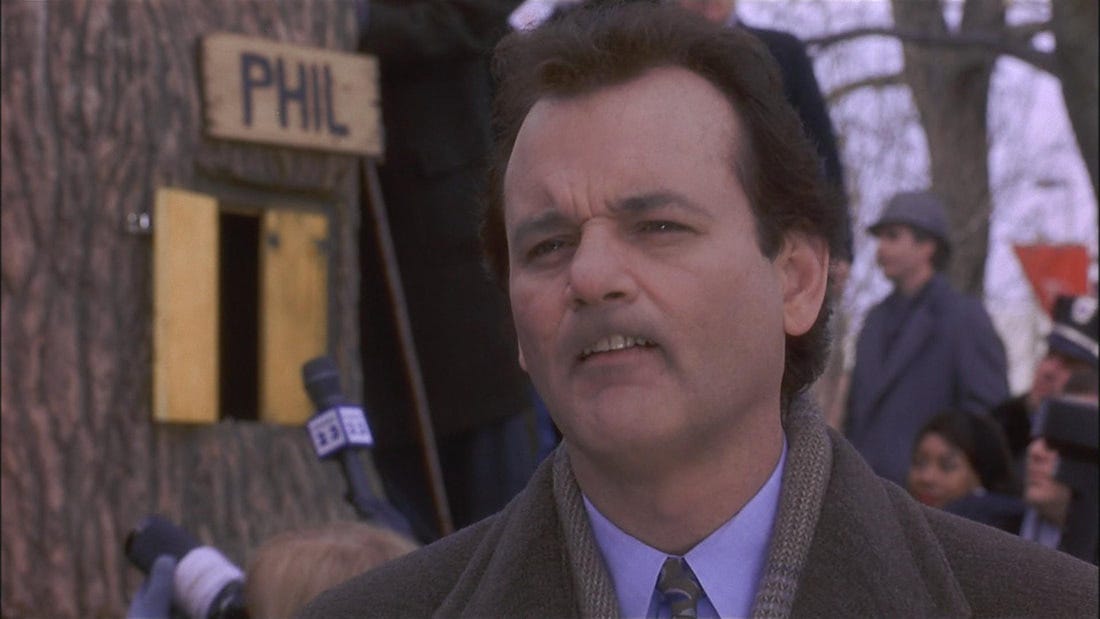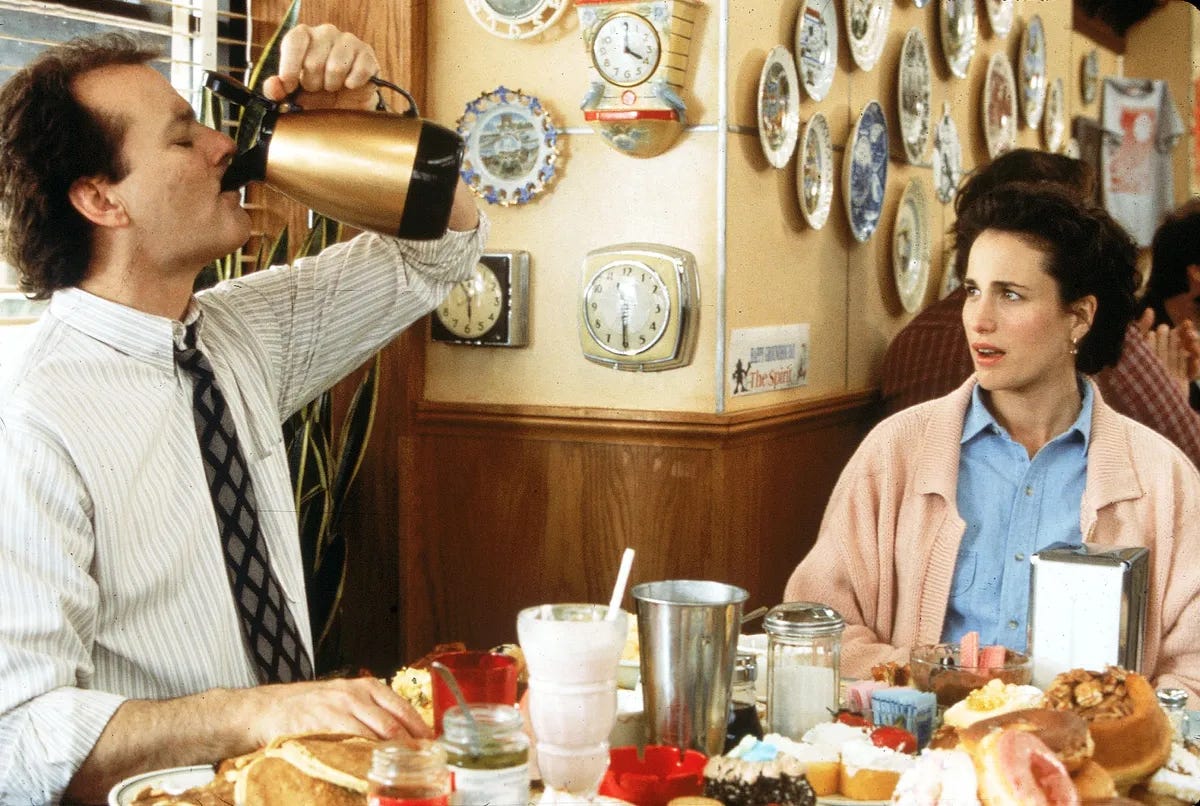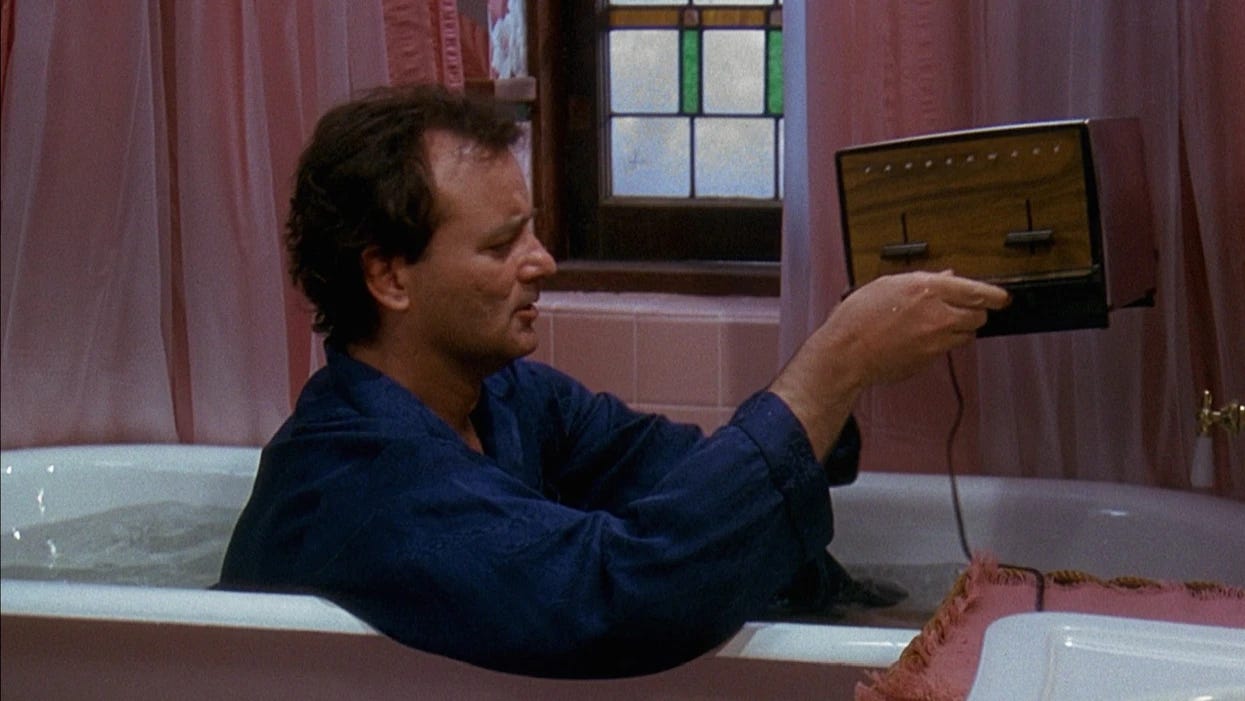Disclaimer: This post includes major spoilers for the Harold Ramis movie Groundhog Day.
Yes, I chose this title because I am fashionably late again. Or maybe you woke up to that same Sonny & Cher song for the third day in a row. If that’s the case, let me know and I’ll write you a fun bucket list. I am, of course, alluding to the classic Bill Murray comedy Groundhog Day, where weatherman Phil Connors suddenly experiences the same day over and over. What a wonderful movie. I watched it for like the 10th time on Saturday.
I want to stress just what a unique movie Groundhog Day is. We could be living in any reality, and somehow, we inhabit the one where a Bill Murray movie made a silly holiday into a byword for a time loop. And singlehandedly created a subgenre, with an impressive number of movies coming at a pace just steady enough to not feel overused1. Very few movies see that level of cultural impact. I cannot conceive of a reality where “Groundhog Day” only conjures the image of a prognosticating rodent.
It’s all in the premise, and in the fact that it’s a really funny movie. This is a message movie through and through, but I think the message is just something extra to appreciate. That’s what I thought for years, at least. I’ve been watching Groundhog Day about every other year since I was 15. And I’m embarrassed I never truly got what it’s about. This isn’t a movie about an asshole who learns how to be nice and appreciate life. It’s about an asshole who learns how to cover for his assholery, in ways that benefit him personally as an asshole.
Let’s look at the ending first. Suddenly everyone loves him and he gets the girl. First of all, Bill Murray’s character never actually cares about Andie Macdowell’s, and there isn’t a moment that this changes. She’s a sounding board for all of his problems, and she’s little more than a prop to him. To the extent that he cares about getting to know her, it’s so that he has something to do other than kill himself repeatedly. They’re coworkers who barely know each other, but to him, that just means she’s more available than all these weirdos in Punxsutawney.
She eventually realizes he’s using her. Of course, to his advantage, she doesn’t remember because she isn’t living through the same day repeatedly. Eventually she falls for him (surprise!) and the tipping point is just that she finds out everyone admires him. He still doesn’t give a shit about her; he’s just managed to figure out how to impress her — and the entire town of Punxsutawney — after repeating the same day countless times. And apparently, all it takes is learning to play jazz piano, sculpt ice, saving kids falling out of trees, practically everything but curing cancer.
To his credit (I guess), none of the “good” stuff he does is ever portrayed as advantageous. It’s two separate storylines that converge in the end — one where he’s trying to get laid, and one where he’s figuring out how to be a good person instead of finding interesting ways to commit suicide. You have to wonder how it’d look for him if these storylines converged earlier in the movie; it’s almost as if there’s a reason that they didn’t.
The Good Samaritan arc also comes out of left field. First we’re led to believe maybe he’s realized he has feelings for her. Then he’s sitting at a restaurant one day listening to Paganini and suddenly has a lightbulb moment. Suddenly, after a whole movie’s worth of suicide attempts and pickup attempts, he’s off on a good deed spree. It seems disingenuous because it is, but ingeniously, it comes off as just one of those Hollywood things you’re supposed to overlook.
And it’s a cynical way to portray suicide. Other than Bill Murray just being a lovable guy, we only feel for his character because his situation led him to 6 attempts. That’s not to minimize suicide or what the character is going through. We definitely wouldn’t buy the idea that he suddenly turns into a good guy, without suicide being used as a heavy emotional ploy. Even though it’s played for laughs, it gets pretty dark.
He’s an unlikable douchebag in just about any other scene (except, you know, he’s Bill Murray). The suicide plot point in this movie is like the “dead dog at the end” trope, except for a full-fledged character, and it’s not at the end; it serves to influence how you feel about him for half the movie. So in a way, this is worse than the dead dog trope. The ending resonates in a completely different way because we have room to see him as a human being. (Because of repeated suicide attempts, and not really because of anything much else.)
What makes it brilliant is that nobody picks up on any of this. This is an underrated screenplay because it comes across as an easy ‘90s comedy watch, which it is, but it’s in many ways really well-written (and ad-libbed). It could’ve been real bad if it weren’t this good. It’s an impressive product, considering Harold Ramis and Bill Murray couldn’t agree on anything2, and Murray was absolutely miserable the whole time.
I’ve seen this movie so many times and always thought of it as a beautiful redemption story. It is not a redemption story! We’re not just watching an asshole perfect his trade; we’re a victim of it. We love him more by the end, not because he’s changed but because he’s learned to present himself in a palatable way.
Great movie, absolutely hilarious, and I will always love Bill Murray. But I am now disillusioned to the fact that Phil Connors is a real asshole. Of all of Bill Murray’s characters, this is the guy I’d least want to meet. And for that, maybe I like the movie even more now. Who actually wants to see Bill Murray as a nice guy? Not I.
For the sake of being pedantic, writers Danny Rubin and Harold Ramis might have gotten the idea from a short film 12:01 PM from three years earlier.
And of the subgenre Groundhog Day spawned, my favorite is Run Lola Run, an action thriller absolutely everybody should see. Even if you struggle to watch arthouse/international movies, it is probably the most entertaining one you’ll ever see.
Ramis wanted more of a romcom, and Murray wanted to lean into its philosophical side. Isn’t that something?







